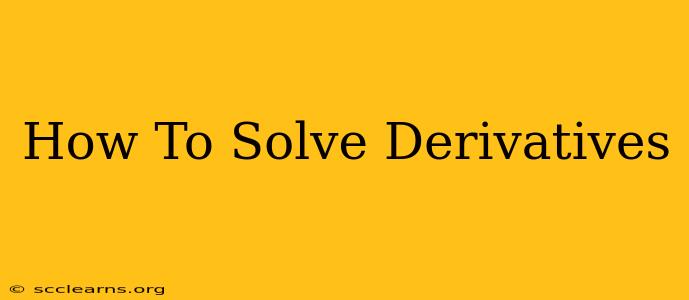Derivatives are a fundamental concept in calculus, representing the instantaneous rate of change of a function. Understanding how to solve derivatives is crucial for anyone studying mathematics, physics, engineering, economics, and many other fields. This comprehensive guide will walk you through the process, covering various techniques and providing examples to solidify your understanding.
Understanding the Basics: What is a Derivative?
Before diving into solving techniques, let's solidify our understanding of what a derivative actually is. The derivative of a function, often denoted as f'(x) or df/dx, measures the slope of the tangent line to the function's graph at a specific point. In simpler terms, it tells us how much the function's output changes for a tiny change in its input.
This concept is closely tied to the limit in calculus. The derivative at a point 'a' is formally defined as:
f'(a) = lim (h→0) [(f(a + h) - f(a)) / h]
This equation represents the slope of the secant line between two points on the function, as the distance between these points (h) approaches zero. The limit process allows us to find the exact slope of the tangent line, which is the derivative.
Essential Rules for Solving Derivatives
Mastering derivatives requires familiarity with several key rules. These rules provide shortcuts for calculating derivatives without resorting to the limit definition every time.
1. Power Rule:
This is the most fundamental rule. For a function of the form f(x) = xn, the derivative is:
f'(x) = nxn-1
Example: If f(x) = x³, then f'(x) = 3x²
2. Constant Multiple Rule:
If you have a constant multiplied by a function, the derivative is the constant multiplied by the derivative of the function.
d/dx [cf(x)] = c * d/dx [f(x)]
Example: If f(x) = 5x², then f'(x) = 5 * 2x = 10x
3. Sum/Difference Rule:
The derivative of a sum (or difference) of functions is the sum (or difference) of their derivatives.
d/dx [f(x) ± g(x)] = d/dx [f(x)] ± d/dx [g(x)]
Example: If f(x) = x² + 3x, then f'(x) = 2x + 3
4. Product Rule:
For a function that is the product of two functions, the derivative is calculated as follows:
d/dx [f(x)g(x)] = f'(x)g(x) + f(x)g'(x)
Example: If f(x) = x²sin(x), then f'(x) = 2xsin(x) + x²cos(x)
5. Quotient Rule:
For a function that is the quotient of two functions:
d/dx [f(x)/g(x)] = [f'(x)g(x) - f(x)g'(x)] / [g(x)]²
Example: If f(x) = x²/ (x +1), then f'(x) = (2x(x+1) - x²)/(x+1)² = (x²+2x)/(x+1)²
6. Chain Rule:
This rule is essential for differentiating composite functions (functions within functions):
d/dx [f(g(x))] = f'(g(x)) * g'(x)
Example: If f(x) = (x² + 1)³, then f'(x) = 3(x² + 1)² * 2x = 6x(x² + 1)²
Solving Derivatives: Step-by-Step Examples
Let's work through a few examples to illustrate the application of these rules:
Example 1: Find the derivative of f(x) = 4x³ - 2x + 7
Using the power rule, constant multiple rule, and sum/difference rule:
f'(x) = 4 * (3x²) - 2 * 1 + 0 = 12x² - 2
Example 2: Find the derivative of f(x) = (x² + 1)(x - 3)
Employing the product rule:
f'(x) = (2x)(x - 3) + (x² + 1)(1) = 2x² - 6x + x² + 1 = 3x² - 6x + 1
Example 3: Find the derivative of f(x) = sin(x²)
Applying the chain rule:
f'(x) = cos(x²) * 2x = 2xcos(x²)
Beyond the Basics: Advanced Techniques
Once you've mastered the fundamental rules, you can explore more advanced techniques such as:
- Implicit Differentiation: Used for functions where y is not explicitly defined as a function of x.
- Logarithmic Differentiation: Simplifies the process of differentiating complex functions involving products, quotients, and powers.
- Derivatives of Trigonometric, Exponential, and Logarithmic Functions: Specific rules apply to these types of functions.
Practice Makes Perfect
The key to mastering derivatives is consistent practice. Work through numerous examples, starting with simple problems and gradually increasing the complexity. Utilize online resources, textbooks, and practice problems to solidify your understanding. With dedication and practice, you will be able to confidently solve derivatives and apply them in various contexts.

